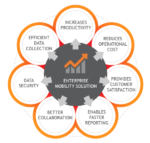What is Enterprise Mobility, and Why is it Important for Businesses?

Enterprise mobility refers to the integration of mobile devices, applications, and technology into the operations and strategies of businesses. With the growing popularity of smartphones and tablets, enterprise mobility has become a critical aspect of modern business, enabling organizations to increase productivity, improve customer engagement, and streamline operations.
 Benefits of Enterprise Mobility
Benefits of Enterprise Mobility
- Increased Productivity: Deskless workers can access company information, communicate with colleagues, and complete work-related tasks while on the go, thanks to enterprise mobility. This increased flexibility allows them to work more efficiently, leading to an increase in productivity.
- Improved Communication: Enterprise mobility enhances communication between deskless workers and their colleagues, customers, and partners. Enterprise-grade devices ensure clear, uninterrupted connections within the 4 walls of the business, and UC gives your deskless workers access to the same tools as their desk-based workers; this allows workers to communicate and share information in real time. This improved communication leads to better decision-making, increased innovation, and higher levels of teamwork.
- Increased Safety: Enterprise mobility can increase the safety of deskless workers by providing them with access to a panic button or emergency call button. Some phones are even able to detect situations where a worker has fallen or is running. This enables lone and mobile workers to summon help quickly, and offers peace of mind on the job.
- Better Data Management: Enterprise mobility and its associated analytics help IT, and telecom teams troubleshoot mobility issues with ease. It provides valuable insights to help manage shared devices and clear visibility into the health and performance of their mobile ecosystem.
- Increased Customer Satisfaction: Enterprise mobility allows deskless workers to respond to customer needs more quickly and effectively. Mobile devices and applications provide real-time access to customer information and product information, allowing workers to respond to customer inquiries, complaints, and requests in a timely manner. This leads to increased customer satisfaction and improved customer relationships.
- Improved Quality of Care: Enterprise mobility can help improve the quality of care for patients by providing healthcare providers with real-time access to critical information. For example, mobile devices can provide healthcare providers with access to patient information, such as medical histories and test results, allowing them to make more informed diagnoses and treatment decisions.
 Factors to Consider when Implementing Enterprise Mobility
Factors to Consider when Implementing Enterprise Mobility
- Device Management: Ensuring that mobile devices are secure, up-to-date, and properly managed is critical to the success of enterprise mobility.
- Mobile Application Management: Businesses must ensure that the mobile applications they use are secure, user-friendly, and optimized for mobile devices.
- Network Security: Network security is a critical component of enterprise mobility, as it protects sensitive business data from cyber threats.
- Data Management: Businesses must have a clear strategy for managing the large amounts of data generated by mobile devices and applications.
- User Experience: Ensuring a positive user experience is essential to the success of enterprise mobility, as users will not adopt solutions that are difficult to use or not optimized for mobile devices.
In conclusion, enterprise mobility is a critical aspect of modern business, providing organizations with new opportunities to increase productivity, improve customer engagement, and streamline operations. However, businesses must carefully consider factors such as device management, mobile application management, network security, data management, and user experience when implementing enterprise mobility solutions. By doing so, they can ensure the success of their enterprise mobility initiatives and gain a competitive advantage in the digital age.
